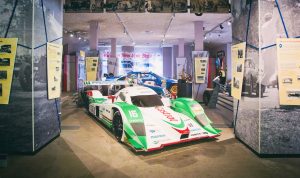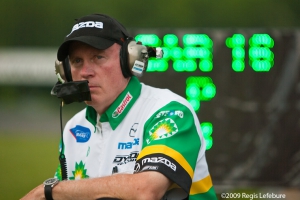Dyson Racing is celebrating its thirtieth year in professional sports car racing this year. The team’s history is rooted in exploring the latest that science has to offer and pioneering new performance enhancements. Technology propels our sport forward, producing the spectacle that brings the fans to the track and tuned into the broadcasts.
In 2009, Dyson racing was the first team in the American Le Mans Series to use a fuel blended with the biofuel isobutanol. The green fuel can be made from sources like crop waste and non-food plants such as switch grass. Using those materials produces a smaller carbon footprint than gasoline or ethanol. Using biomass can also produce a negative carbon imprint when the carbon dioxide absorbed by the growing crops offsets the emissions produced from being cultivated, processed and burned in engines. When burned in an engine, isobutanol produces carbon dioxide, but no SOX, NOX, or carbon monoxide and is much less evaporative than ethanol or gasoline. “Racing has the responsibility to lead by example. Motor racing’s DNA is not just about racing,” noted Chris Dyson. “It is about pushing the boundaries of future technologies that make their way into regular road-going applications.”
Earlier this year, the leading auto manufactures made a point of showcasing the latest efficiencies of smaller engines at a number of international auto shows. Dyson Racing first ran their turbocharged two-liter in-line four cylinder engine in 2002 and the following year won the ALMS LMP675 driver’s and team championships with the Advanced Engine Research built engine. At the Sonoma race that year, the Dyson Lola was the first LMP675 car to take pole and win overall, winning over the larger Audi R8 LMP900 entry. In 2011, the Mazda-powered Dyson team swept the championship table with five championships overall with their turbo two-liter four cylinder taking home the honors over the Muscle Milk car powered by a naturally aspirated V-12 Aston Martin engine. For years, Dyson Racing has run the lightest and smallest P1 engine in the ALMS.
And last year, the team introduced the new Flybrid Kinetic Recovery System at the Virginia International Raceway ALMS race and ran it at the last two races of the season. It was the first of its kind to race outside of Europe. The KERS system is purely mechanical and fits between the engine and transmission in the bell housing. It is based on a high-speed, lightweight flywheel that stores braking energy for later use under acceleration. The steel and carbon fiber energy flywheel weighs just eleven pounds and can rotate up to 60,000 RPM to allow storage of up to 134 HP for up to five seconds during each braking manoeuvre.
And now the latest in shock absorber technology also has a spinning element. The inerter shock got its start in Formula One, is used by IndyCar teams and last year, Dyson Racing adapted them to their Mazda-powered Thetford/RACER P1 Lolas.
The inerter shock is a combination mechanical and hydraulic damper. There is a ball screw with a weight on it. When the shock compresses, the weight spins clockwise and when the shock extends, the weight stops, changes directions and reaccelerate the other way. When you hit a bump, it spins the weight on a shaft in the shock and then when the suspension wants to change directions, the weight resists the change. To the driver, it calms the car down and takes the “road noise” out.
“When we first put them on the car at a test at Monticello, it was like going from an AM radio station to an FM radio station,” said Chris Dyson. “You are going down the back straight at 160 mph and everything is moving and buzzing and then we put the inerter shocks on all, everything was much smoother.”
In effect, the spinning mass slows down the reaction of the shock and makes it smoother to the driver. The more mass put in the shock, the less hydraulic damping is needed because the mass is controlling the movement of the car. So one of the benefits is the ability to use less hydraulic damping, run a softer spring and let the spinning weight smooth out the car’s movement. It also provides an aero advantage because the ride height tends to change less, and also helps mechanical grip because the elements that excite and cause the tire contact patch to change shape get smoothed out so the average size of your contact patch is bigger and there is more grip.
The inerter shock gives you a higher range of tunability. With the Penske 8780 shock absorber, you have 50 clicks of bleed on the bump side, 50 clicks of bleed on the rebound side and 75 clicks of high speed blow-off. On each side of the piston, there are three bleeds that screw into the piston that can be tuned and then you have an inner stack of shims and an outer stack of shims within the shock. Basically your inner stack is your high speed control and the outer stack is your low speed control. All this allows you to use the shock to find grip and the spring to support the car.
That is the advantage of the inerter shock. You can run softer springs, have more compliance and more low speed mechanical grip, but still be able to control the aero platform at speed and get more aero performance.
At Mazda Raceway Laguna Seca in May of this year, Dyson Racing debuted the Advanced Engine Research (AER) developed P90 Mazda engine. An update to the P80, the engine features gasoline direct injection. “The P90 delivers more horsepower, more torque, better drivability and better fuel economy. It is a responsive engine with all the inherent benefits that gasoline direct injection gives you,” noted Andrew Saunders, Engineering Manager of AER. “The fueling commands from the ECU are instantaneous and that carries more benefits for a restricted turbo charged engine than it does for any other engine application. In a GDI turbo engine, the fuel cuts you make are as instantaneous as the spark cuts which bring you on a more level playing field with normally aspirated engines. This is very good for traction control and all the drivability events you need on track.”
From its very beginning, racing has simultaneously pushed the envelopes of speed and technology. And developments never stand still at Dyson Racing. “We have always been interested in new technology,” said Rob Dyson, team founder. “That has been a constant for thirty years. We are hot rodders at heart, always looking to go faster.”


